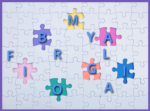
In my search for relief from chronic pain, I would often come across recommendations to exercise. My immediate reaction was: Exercise?! Are you kidding? It hurts to breathe!
If you have chronic pain, you probably wince at the thought of physical activity. Just getting to the bathroom can be like running a marathon. You need a nap after taking a shower. Pain zaps your energy. People don’t often think about that part. Chronic pain is a double-whammy: pain and fatigue. Coping with constant pain is exhausting.
The irony is that exercise does help. Not only does it release endorphins – the natural pain killers – but studies show that regular exercise improves a person’s ability to manage stress. And what’s more stressful than coping with chronic pain?
The trick is that the only way to make exercise work for you is to like it. Not make yourself like it. I mean actually like it.
How, pray tell, does one learn to like exercise when the body hurts all the time? After years of giving exercise the finger, here’s how I finally did it.
1. Don’t force yourself. Teach yourself.
Think of exercise as an acquired taste. A new skill. It’s a process. Ease into it. Learn about it. Read up on it. Drop the idea for a while. Mull it over again. Replace the “I should” thoughts with “That might be interesting to try sometime.” Act only when you are psychologically ready to. It might take years. There’s no timetable. You’re ready when you’re ready.
2. Throw the masochistic saying, “No Pain, No Gain” in the trashcan.
Don’t try to exercise when your pain and/or fatigue is really bad. Your brain will rebel, associating exercise with bad feelings. The human brain is wired to seek pleasure and avoid pain. Fighting that basic instinct is a losing battle.
Find small pockets of time where you’re feeling relatively well. Use those ten minutes when your pain pills first kick in. Exercise later in the day after your body and brain has eased into some activity.
3. This is Your Mantra: Slow, Easy & Short
When you are ready to actually start moving your body, start with slow and easy movements of short duration. And I mean VERY slow and easy. Like “just flex your feet and hands while laying down” easy. Like only 5 minutes short. Seriously, five minutes only!
There are lots of movements you can do laying down or sitting. I found this great set of leg strengthening exercises specifically for sitting or laying down. Exercising in a swimming pool can be helpful (that’s my favorite).
Everyone is different, so work with your healthcare provider to find movement that’s appropriate for you.
Whatever it is, start really, really slow, really, really easy, and for a very, very short amount of time.
4. Don’t – I Repeat DON’T – Overdo It
Whatever you do, do not overdo it. Listen to your body. You know when it’s had enough. Even if it’s only 5 minutes. If you’re getting fatigued, STOP!
This is especially important if you have fibromyalgia, because our bodies tend to react strongly to stress. Pushing yourself will only backfire.
Also be aware of when you’re feeling good and want to exercise more than usual. Be careful and don’t overdo it. Your body will let you know the next day if you have!
Learn your limits and abide by them. Increase those limits very, very gradually.



